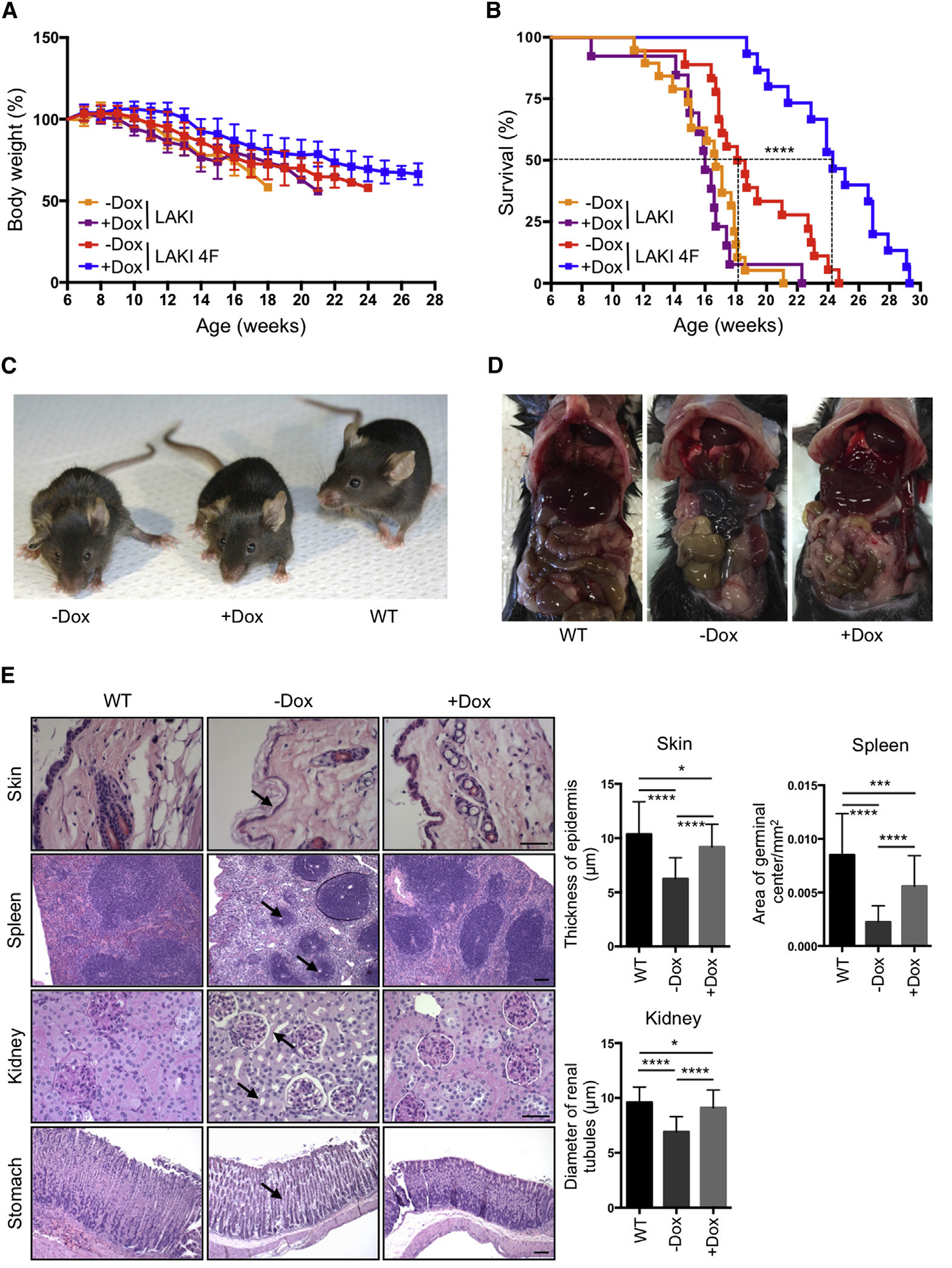Gene therapy extends the life of mice by 30%

Comparative condition of mice. A reprogrammed + Dox mouse state is much better than a −Dox mouse of the same age. The experiment involved mice with a rare genetic disease - Hutchinson-Gilford syndrome , which causes premature aging. Such mice were taken for convenience in order for aging to come faster and the results of cellular reprogramming appear.
Aging of the body increases the risk of developing many diseases and death. Therefore, scientists have long been looking for ways to change the body's biological programs in order to prolong youth and delay the onset of old age. Perhaps, in the future, it will be possible to prevent the onset of old age in general, which will significantly reduce the risks of disease and increase the average life expectancy of the most worthy people.
Previous in vitro studies have shown that the possibility of cell rejuvenation does exist. This was shown by cell reprogramming, that is, by using induced stem cells obtained from pluripotent cells by epigenetic programming.
Laboratory experiments in vitro confirmed the fact of rejuvenation, and now scientists have conducted an experiment for the first time on living beings , that is, inside a living organism (in vivo). In a well-studied area of cell reprogramming, American scientists did not invent anything fundamentally new, but now you can compare with your own eyes an old live mouse with a rejuvenated live mouse of the same biological age (see photo C in the illustration above). The transition from in vitro experiments to experiments on living organisms is a giant step forward towards real genetic experiments on humans.
')
Cell reprogramming
Reprogramming of the genetic system of cells occurs under the influence of reprogramming factors. Simply put, using drug-induced viral transgenes 0ct4, Sox2, Klf4 and c-Myc.
As a result, some somatic cells bypass the mechanisms of cell aging and, as a result of the expression, 0ct4, Sox2, Klf4 and c-Myc turn into induced pluripotent stem CiPSD cells. In a living being, this means the rejuvenation of the body with all the attendant effects - improving the state of various systems and increasing the average life expectancy.

Mouse muscle tissue before and after reprogramming cells
Unlike genetic engineering, it uses the methods of epigenetics , that is, the "inclusion" and "off" of genes that already exist in the body, without directly changing the DNA.
In this case, the expression of 0ct4, Sox2, Klf4 and c-Myc performs the control function. These specific genes are active only in embryos, and in an adult they should not work. If they are artificially activated in an adult, then normal adult cells are reprogrammed back into stem cells. There is a regeneration of tissues and the biological age of the body, as it were, "decreases".
The experiment with the rejuvenation of older cells was successfully conducted in 2011 in vitro. Now it was repeated in vivo, that is, in the living body of the mouse. Scientists have managed to find such a method of cyclic gene therapy, which eliminates the side effects - premature mortality and the formation of teratomas - and really prolongs the life of mice.
According to scientists, this method will not work in humans. However, this process will allow a better understanding of the fundamental causes of aging and the identification of direct biological factors, due to which the body at a certain moment loses its ability to regenerate and reproduce.
Causes of Aging
The onset of body degradation and aging is one of the biggest mysteries in biology. Why do some body tissues regenerate and never age (for example, reproductive cells), while others include a mechanism of degradation?
At the moment, scientists have no consensus about the causes of aging. The most authoritative are considered evolutionary-genetic and evolutionary-physical theory. Proponents of the first theory believe that aging is caused by the accumulation of mutations in the body, including under the influence of special pleiotropic genes. The adherents of the second theory believe that aging is due to the most optimal distribution of body resources .
In any case, using genetic engineering methods, you can try to make changes and correct errors in the embedded biological programs. If we consider aging such an error, then it can theoretically be corrected.
There are still many unexplored questions regarding this method of rejuvenation. First, it should be tested in healthy animals, and not only in mice with a congenital defect of premature aging. Secondly, one should make sure that all organs are equally affected by rejuvenation. For example, what happens in a central system where cell replacement is limited? Agree, because no one wants to stay in a young body with healthy organs and strong muscles, but with the old brain.
So far, the social consequences of increasing the life expectancy of the entire population or part of it are not well studied. Of course, people will continue to die in wars, in road accidents, from accidents and from deadly diseases. In the end, no one will live forever, but to predict the duration of a particular person in the absence of guaranteed aging will be very problematic. If we assume that the aging of the body is absent, then it is not clear at what level to set the retirement age and begin to pay a pension. This is probably not the only problem that humanity will face with an increase in life expectancy.
The scientific work was published on December 15, 2016 in the journal Cell (doi: 10.1016 / j.cell.2016.11.052, pdf ).
Source: https://habr.com/ru/post/399997/
All Articles